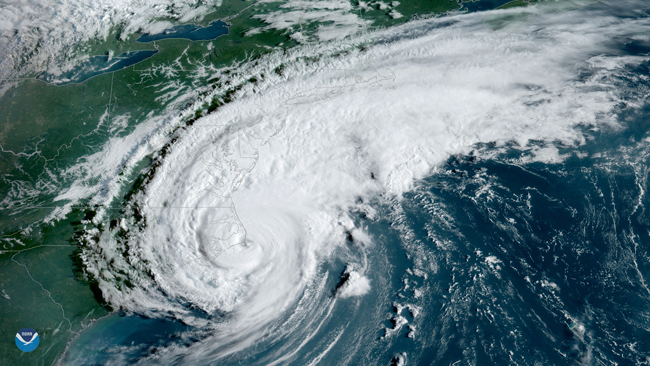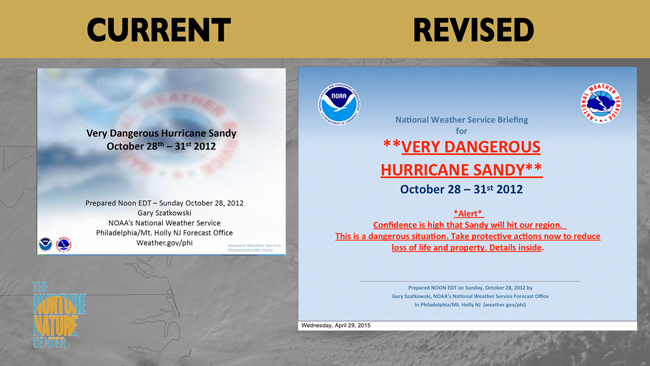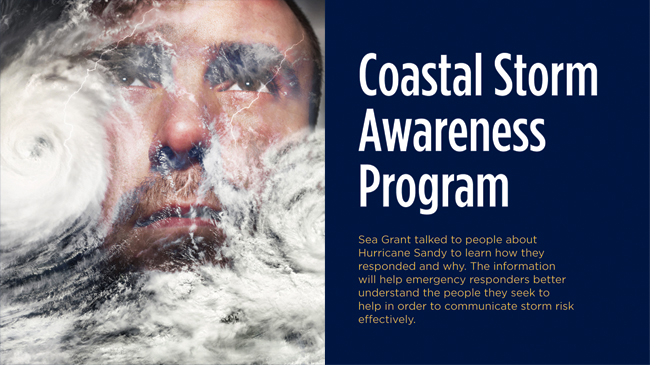
Hurricane Dorian made landfall over Cape Hatteras, N.C., at 8:35 a.m. EDT on Friday, Sept. 6, 2019, with maximum sustained winds near 90 mph. NOAA’s GOES East captured this view of the strong Category 1 storm at 8:20 a.m. EDT, just 15 minutes before the center of the storm moved across the barrier islands. While Dorian lashed the Bahamas as a Category 5 storm throughout Labor Day weekend, two other storms were brewing — one in the Atlantic (Tropical Storm Fernand), and another in the Eastern Pacific (Hurricane Juliette). Credit: NOAA.
New York, NY, September 7, 2019 - The National Oceanic and Atmospheric Administration (NOAA)'s National Weather Service (NWS) has adopted Eastern Region’s new storm briefing template nationwide.
This is according to recently-reported findings from Easton, Pennsylvania's Nature Nurture Center, which conducted one of the 10 Coastal Storm Awareness Program (CSAP) social science projects funded via the National Oceanic and Atmospheric Administration and its Sea Grant programs in New Jersey, New York and Connecticut.

Before and After designs for briefing books produced by the National Weather Service. Credit: Nurture Nature Center.
Here's a summary of that research and how its been applied, as told via "the Four R-s," relevance, response, results and recap ...
RELEVANCE: NOAA NWS storm briefing products are a critical source of information used by local officials and emergency managers to assess risk and determine actions to prevent loss of life and property. As part of the CSAP, New Jersey, New York and Connecticut Sea Grant supported social science research that evaluated NWS storm briefing materials and their use.
Project findings included: while the NWS is the authoritative information source, residents prefer to receive warnings from local municipal and emergency management sources; NWS emergency briefing packages are the preferred method for disseminating storm/flood risk information; and risk is communicated most effectively through visually and graphically clear, succinct localized messages.
RESPONSE: In 2016, the director of the NWS Eastern Region requested development of a new standardized storm briefing template for use by all Weather Forecasting Offices (WFOs) in that region. The new Decision Support Service (DSS) template contains core elements, incorporates probabilistic forecasting and integrates the Sea Grant social science research recommendations for improving visual/graphical clarity and overall messaging of the briefing materials. First issued in December 2016 by the Grey, Maine WFO, the new template received positive feedback from agency and community officials.
RESULTS: Following successful adoption and implementation of the new DSS briefing template by the Eastern Region WFOs, the template was made available in the NWS DSS toolkit for use across the entire Service. The template was used during the 2019 Hurricane Season and adopted nationwide as the template for all tropical storm-related briefings.
RECAP: A new standardized Decision Support Services storm briefing template developed for National Weather Service Eastern Region Weather Forecasting Offices incorporates recommendations from a Sea Grant Coastal Storm Awareness social science research project focused on improving visual/graphic clarity and messaging of storm briefing materials.
Made broadly available, the template was used during the 2019 Hurricane Season and adopted nationwide as the template for all tropical storm-related briefings.
For more on recent findings from this and other CSAP-funded projects, see the March 2019 story, "Coastal Residents Wary of Storms and Preparing."

More Info: NOAA Sea Grant’s Coastal Storm Awareness Program
VIDEO: NOAA Sea Grant documentary short on coastal storm awareness educates emergency managers, empowers coastal communities. Video also points to resources from NOAA's National Weather Service, the Federal Emergency Management Agency, NYC Office of Emergency Management and more. The 4-1/2 minute trailer for NOAA Sea Grant's Coastal Storm Awareness Program's 23-minute documentary, view-able on YouTube.
AUDIO: Theme Song: "Ask Yourself," Written and performed by Barbara A. Branca
Note: If you don't see the player above, it's because you're using a non-Flash device (eg, iPhone or iPad).
Superstorm Sandy in 2012 triggered a nationwide reassessment of coastal storm preparedness in the United States, including in the heavily impacted tri-state region (New Jersey, New York, Connecticut). Nearly 150 deaths and an estimated $50 billion in property damage were attributed to this storm.
Despite forecasts for the late October 2012 storm, too many coastal residents either failed to fully understand the severity of the storm and the dangerous conditions it would produce, or chose not to evacuate in spite of the serious risks of staying in their homes.
And so, the aim of the NOAA Sea Grant’s Coastal Storm Awareness Program (CSAP) was to help better understand through social science how people react to storm warnings and make the decision to stay or to go.
The suite of 10 studies, which was competitively funded at institutions from Yale University to Mississippi State University via Sandy Supplemental funds appropriated by Congress under the Disaster Relief Appropriations Act of 2013. This national competition drew on the decades of experience within NOAA and Sea Grant as well as the well-earned reputation for credibility and trust of the Sea Grant outreach communities in the tri-state region. By combining Sea Grant’s established relationship within local communities with current social science research, this effort helped to maximize awareness and understanding of the true severity of coastal hazards - even amongst hard to reach, isolated groups within communities.
Through research and outreach, both the quality of available information on coastal storm risks to humans, and understanding of factors influencing decisions by coastal residents in response to storm warnings was improved. Coastal storm communication professionals and emergency managers were the primary target audiences for CSAP outcomes. A Program Steering Committee of stakeholders helped guide the program and review the results.
Sea Grant staff and funded researchers shared results of the social science research at several key venues during this multi-year endeavor. Presentations were given at the Interagency Coordinating Committee on Hurricanes annual meeting in Fort Worth TX, at the National Hurricane Conference in New Orleans LA, at the NOAA National Hurricane Center in Miami, and at the Governor’s Hurricane Conference in West Palm Beach FL. Key audience members were local, state and federal officials involved in storm predictions, risk communication, storm preparation and emergency management and response. Numerous requests for additional information were met.
Research findings and related outreach efforts are detailed in a May 2016 comprehensive summary, "NOAA Sea Grant Coastal Storm Awareness Program Comes Ashore." Additionally, you can find a visual wrap-up of this research suite via a 23-minute short documentary and its companion four-and-a-half minute video trailer, which were also released that spring. Both point to resources from NOAA's National Weather Service, the Federal Emergency Management Agency, NYC Office of Emergency Management and more.
For more on NOAA Sea Grant's Coastal Storm Awareness Program see www.nyseagrant.org/csap. NYSG also offers additional resources on severe storms at www.nyseagrant.org/hurricane and www.nyseagrant.org/superstormsandy.
More Info: New York Sea Grant
New York Sea Grant (NYSG), a cooperative program of Cornell University
and the State University of New York (SUNY), is one of 33 university-based
programs under the National Oceanic and Atmospheric Administration’s
National Sea Grant College Program.
Since 1971, NYSG has represented a statewide network of integrated
research, education and extension services promoting coastal community
economic vitality, environmental sustainability and citizen awareness
and understanding about the State’s marine and Great Lakes resources.
Through NYSG’s efforts, the combined talents of university scientists
and extension specialists help develop and transfer science-based
information to many coastal user groups—businesses and industries,
federal, state and local government decision-makers and agency managers,
educators, the media and the interested public.
The program maintains Great Lakes offices at Cornell University, SUNY
Buffalo, SUNY Oswego and the Wayne County Cooperative Extension office
in Newark. In the State's marine waters, NYSG has offices at Stony Brook
University in Long Island, Brooklyn College and Cornell Cooperative
Extension in NYC and Kingston in the Hudson Valley.
For updates on Sea Grant activities: www.nyseagrant.org has RSS, Facebook, Twitter, and YouTube links. NYSG offers a free e-list sign up via www.nyseagrant.org/nycoastlines for its flagship publication, NY Coastlines/Currents, which is published quarterly. Our program also produces an occasional e-newsletter,"NOAA Sea Grant's Social Media Review," via its blog, www.nyseagrant.org/blog.